Every presentation is different, reflecting your unique business and the information you share. But, some common presentation types are used across various fields and teams. Before diving into specific slides or organization, consider the type that best suits your audience.
Here are some questions to get you started: Is your goal to inform or entertain? Who will you be speaking to: colleagues, investors, or potential customers? By thinking about these questions, you can choose the presentation format that best supports your message.
SlidesAI can help you simplify this process even further by providing descriptions of different presentation types.
Why Do We Need Different Types of Presentations?
Presentations are a great way to share ideas and information in different situations, depending on who you’re talking to. What you want to achieve with your presentation can change who it’s for and how you present it.
For instance, if you’re trying to sell something, you might want a presentation that convinces people and is visually interesting. On the other hand, teaching something might require a more step-by-step approach with lots of details.
The best type of presentation depends on a few things, like what you’re trying to accomplish, the audience’s interests, and what you’re good at as a presenter. By choosing the right kind of presentation, you can get your message across clearly and achieve what you set out to do.

What are the Different Types of Presentations?
1. Educational Presentations
Educational presentations are a great way to introduce a new topic to people who aren’t familiar with it. They can be especially helpful when you want to explain something complex, like a process, or share important facts in a clear way. Whether you’re a teacher in a classroom or a trainer at a company, educational presentations can be a powerful tool for learning.
These presentations often use visuals like pictures or diagrams to make things easier to understand. They might also include step-by-step instructions to guide the audience through a process. Companies use them a lot to teach new employees about how things work at the company. The length of the presentation can be short or long, depending on what you’re trying to teach.

2. Instructional Presentations
Instructional presentations help people learn more about a topic and sometimes even guide them on what to do next. They’re similar to presentations used for education, but they might include some extra details or specific steps for the audience to follow.
Think of webinars or training sessions – these are examples of instructional presentations. They give people new information and help them develop new skills. For instance, if you’re in HR, you might create one to explain how employees can sign up for the new insurance plan.
Checkout Our Business Presentation Templates
Download Free Business Presentation Templates Now!
3. Persuasive Presentations
Many presentations aim to convince the audience of something, like a new idea, product, or way of doing things. They often address a specific issue and use facts and figures to explain why their solution is the best. Business proposals and sales talks are common examples.
For instance, a new company seeking funding might create a presentation to convince investors to support their idea. This presentation could explain a problem they see in the market, how their company solves it, and how they plan to make money. A similar presentation could also be used to secure additional funding for growth and future plans.
Also Read – How to Create a Pitch Deck with AI?
4. Motivational Presentation
Motivational presentations aim to lift up the audience’s spirits and help them deal with challenges. They spark interest in a subject and share a particular perspective or message. These presentations can be useful when you want to inspire a group of people. Sometimes, they might even use a personal story to connect with the topic.
Leaders in organizations often use motivational presentations to boost employee morale and encourage them to work harder. Recruiters might also use them to showcase employee success stories and get potential hires excited about joining the company.
Acknowledging team efforts through platforms like the Kudos platform can further boost motivation and encourage a positive response to challenges.

5. Problem-Solution Presentation
Have you ever needed to present an idea to help people make a decision? Problem-solution presentations are a great way to do that. They focus on explaining a challenge or issue and then offering potential solutions for the audience to consider. While similar to persuasive presentations, the main goal here is to discuss the problem clearly and share research so decision-makers can weigh the options and choose the best path forward. These presentations can include details about the problem and a few possible solutions. They’re a handy tool for many business meetings and discussions within organizations.
6. Progress Presentations
Progress presentations are a way to share how a project, campaign, or initiative is moving along. They’re similar to progress reports, but in a presentation format.
These presentations typically cover a few key points:
- Important measurements: This could include numbers or data that show how the project is doing.
- Current status: An update on where things stand at the moment.
- Potential roadblocks: Any challenges that might come up down the line.
- Tasks still to do: What needs to be completed next?
Project teams often use progress presentations to share updates on their work. This allows clients, colleagues, or other interested parties to stay informed and ask questions if needed.
7. Storytelling Presentations
Presentations that use a story format can be a great way to connect with your audience and share information in a more engaging way. This approach can be useful in many settings, from classrooms to company meetings. It can be especially helpful when you want to grab the attention of a specific group of people and make them feel involved.
Storytelling presentations might include personal stories or examples that relate directly to the main topic. For instance, if you’re in marketing, you could use a story format to present a case study to your colleagues about a competitor’s product and its success.
Checkout Our Templates for Your Product Marketing
Download Marketing Presentation Templates Now!
8. Visual Presentations
Presentations come in many forms, but some rely mostly on pictures, charts, and other visuals instead of text. These are called visual presentations. They’re a good choice when you have limited time or your topic is easy to understand with pictures.
The goal of a visual presentation is to help people grasp the information quickly and keep them engaged. Businesses often use them to show what their products or services can do. For instance, a company selling shampoo might use before-and-after pictures to show the results.
Pro tip: Elevate your visual presentations with an AI Native Visual Communication Tool for smarter design and greater impact.
9. Demonstrative presentation
A demonstrative presentation is a hands-on, step-by-step presentation that shows the audience how something works or how to perform a specific task. It often includes live demonstrations, visuals, or practical examples to make the process easy to understand. These presentations are highly interactive and focus on breaking down complex tasks into clear, manageable steps. They’re commonly used for product demos, software tutorials, technical walkthroughs, and training sessions.
For instance, a software trainer demonstrates how to use a new CRM tool, showing each step on screen while explaining its features and benefits.
10. Decision-Making Presentation
A decision-making presentation helps stakeholders choose the best course of action by clearly presenting a problem, relevant data, and multiple possible solutions. Instead of pushing a single viewpoint, it objectively explains the pros, cons, risks, and expected outcomes for each option. The goal is to provide enough clarity and evidence so the audience can make an informed, confident decision. These presentations are often used in strategic planning, budgeting, project approvals, and organizational problem-solving.
For instance, a marketing team presents three campaign strategies comparing budgets, projected ROI, timelines, and risks so leadership can decide which campaign to launch for the next quarter.
<SlidesAICTA2 />
Tips for Delivering an Effective Presentation
- Taking Notes: To help remember what to say during your presentation, jot down some brief notes. Keep them simple and focused on keywords or short directions. This will allow you to connect with your audience and avoid missing any important points.
- Knowing Your Audience: A little research about your audience before your presentation goes a long way. Understanding who they are and what they might be interested in helps you tailor your presentation to better address their needs and expectations.
- Planning for Interaction: Think about how much audience interaction you want based on the length, purpose, and type of information in your presentation. This may involve allocating more time for questions and discussion.
- Know yourself: Think about how comfortable you feel speaking in front of a group, especially if you don’t know everyone. Consider your strengths and weaknesses as a presenter and how you can play to your strengths and improve on your weaknesses.
- Practice Makes Perfect: Practicing your presentation beforehand, regardless of your experience level, can boost your confidence and help you identify areas for improvement. Go through each slide while talking to solidify the flow. Recording yourself can also be helpful.
- Be Prepared: Technical problems can happen, so having a plan can help you avoid delays. If it’s an in-person presentation, arriving early allows you to check the venue and ensure the equipment works properly.
Also Read – Presentation Aids: Ideas to Lift Your Presentation
How to Create a Presentation with SlidesAI?
Step 1: Add SlidesAI Google Slides add-on or PowerPoint add-in
For Google Slides: Open the blank Google Slides Presentation. Go to extension > Add on > Get Add on
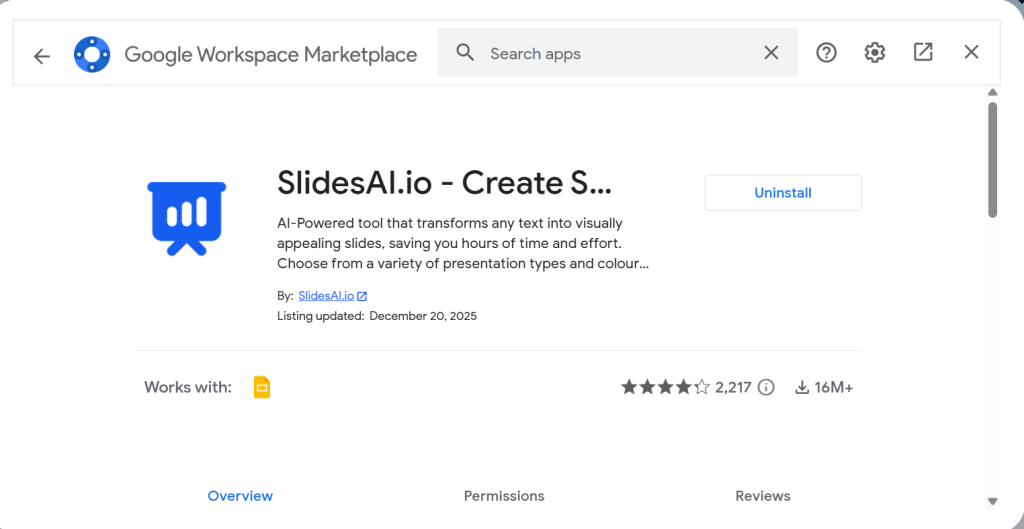
For PowerPoint: Open a blank presentation. Go to Add-ins, search for SlidesAI and add the add-in
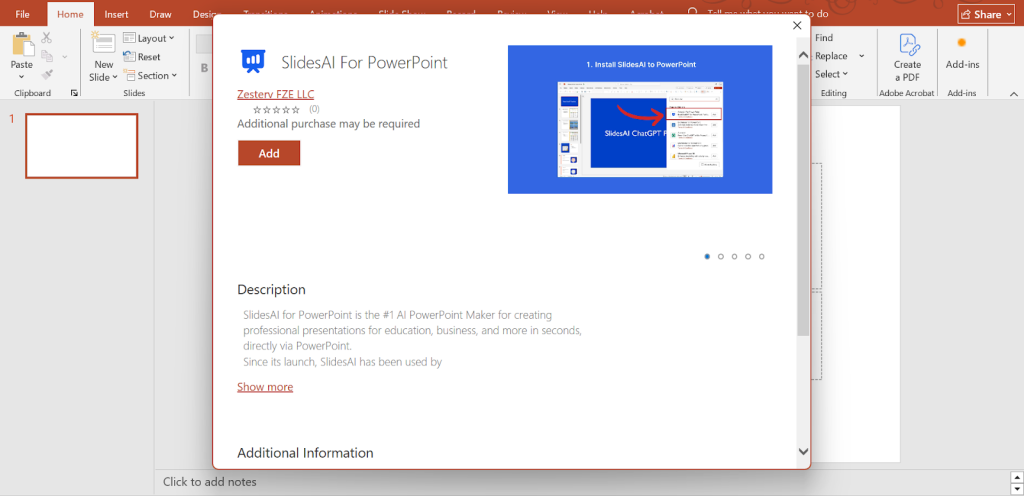
Step 2: Generate a new presentation
For Google Slides:
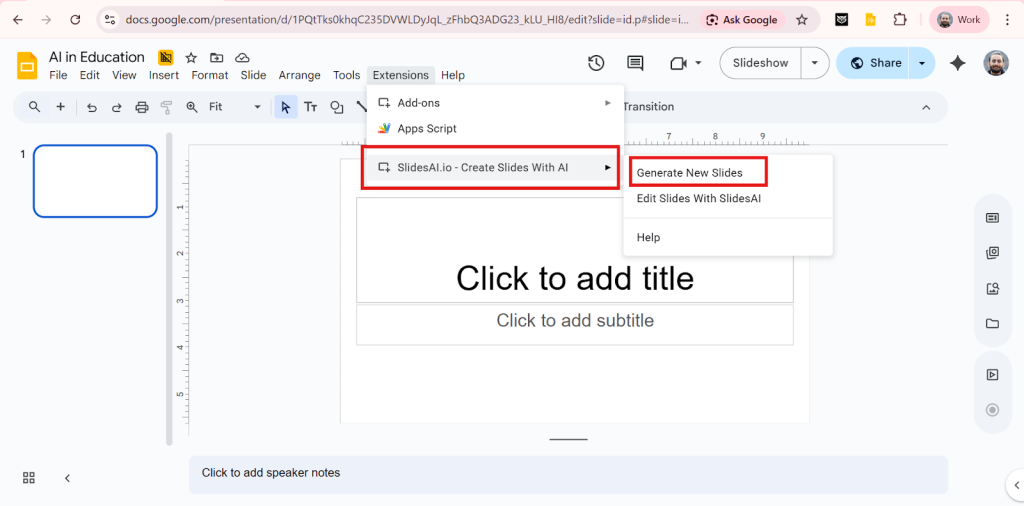
For PowerPoint:
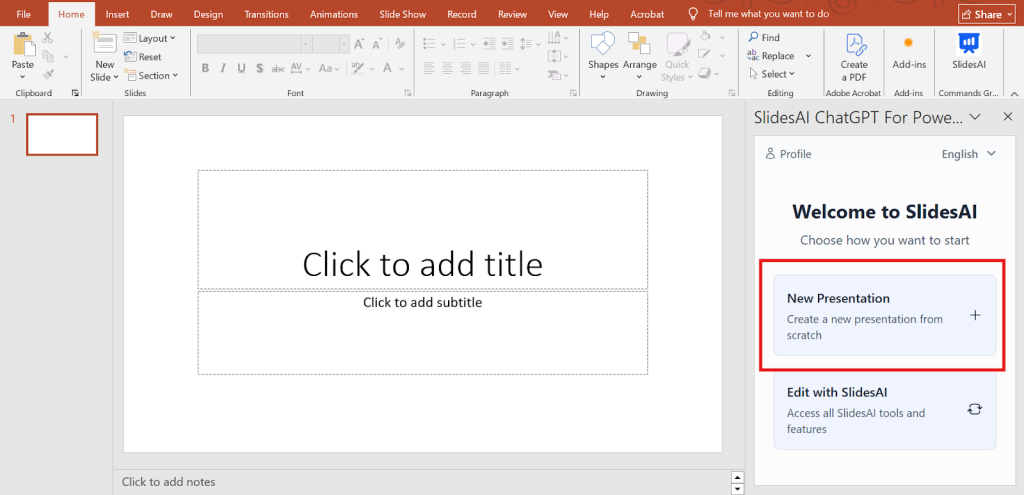
Step 3: Enter the topic of your presentation

Step 4: Select the presentation type, audience, tone of voice, and language as per your presentation and audience.
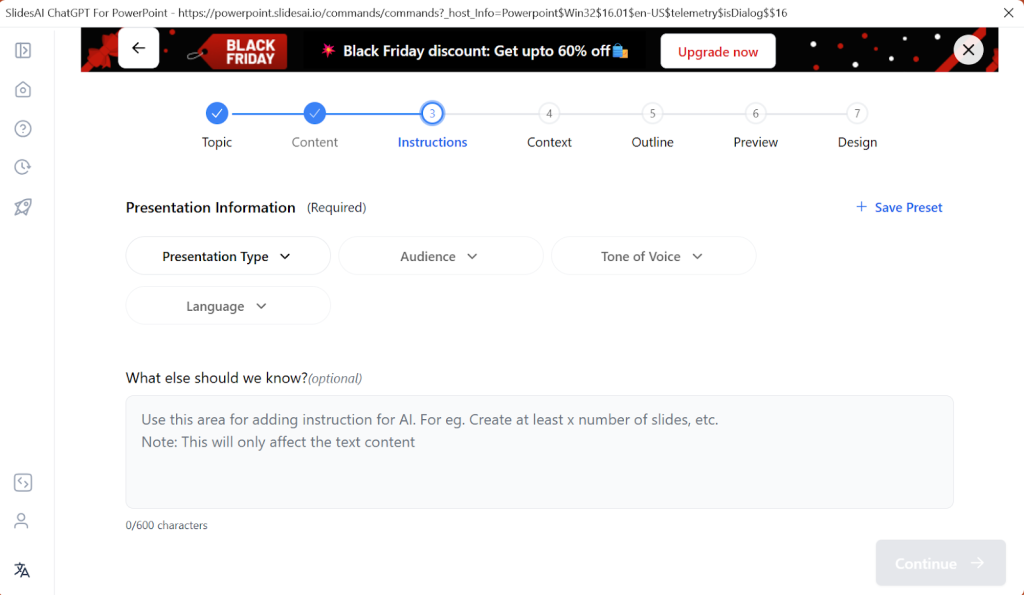
Step 5: Select the content of your presentation to “Presenting Live”
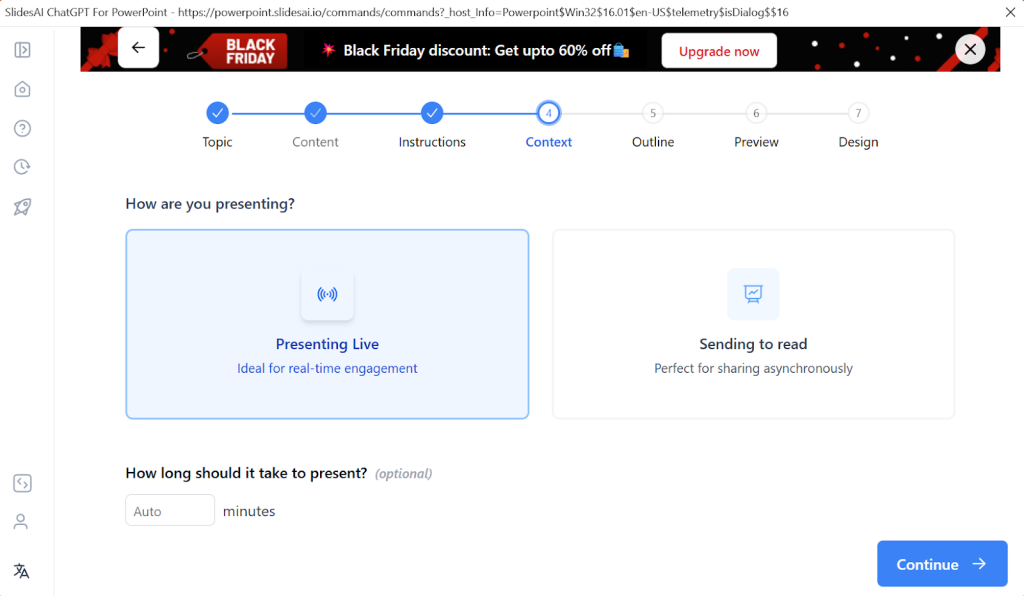
Step 6: SlidesAI will generate the outline for your presentation. Review your outline
Step 7: Review the content for your presentation
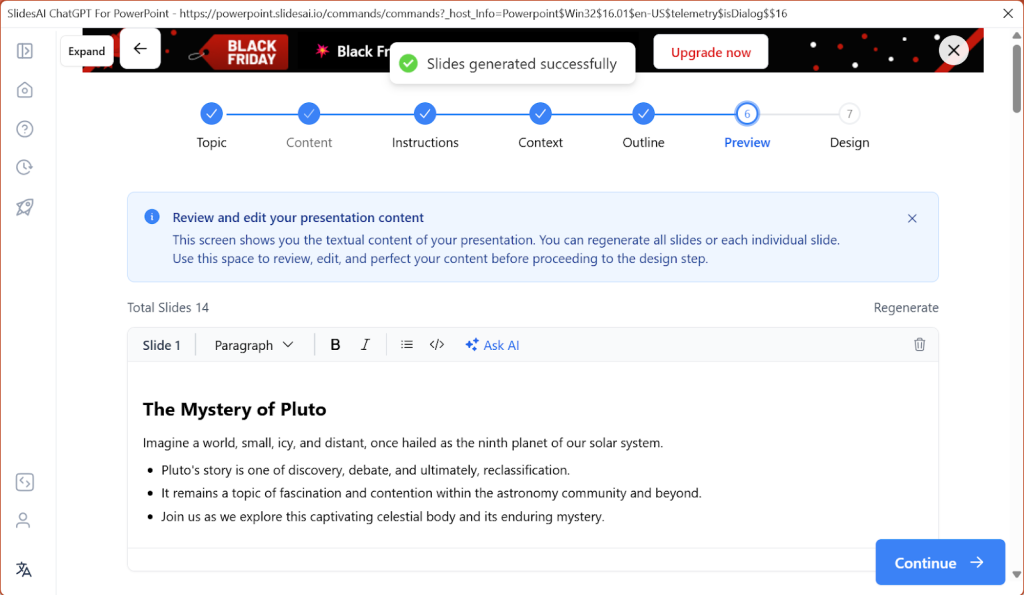
Step 8: Select the template of your choice for your presentation

Step 9: Review the final presentation generated by SlidesAI
<SlidesAICTA1 />
Frequently Asked Questions About Types of Presentation
How can I grab attention at the beginning of my presentation?
There are several ways to hook your audience from the start. Try opening with a surprising fact, a thought-provoking question, or even a short, interesting story related to your topic.
How long should my presentation be?
Ideally, aim for a presentation between 10-20 minutes. This timeframe allows you to cover the important points without losing your audience’s attention.
What are the 5 keys to a successful presentation?
Here are 5 keys to delivering a pitch-perfect presentation:
- Know your audience
- Master your material
- Make it a conversation
- Be adaptable
- Show empathy
Which presentation software should I use?
Several popular options are available, including Microsoft PowerPoint, and Google Slides. The best choice depends on your specific needs and comfort level. Additionally, SlidesAI.io is a helpful tool for creating visually engaging presentations. Consider your needs and choose the software that best suits you.




